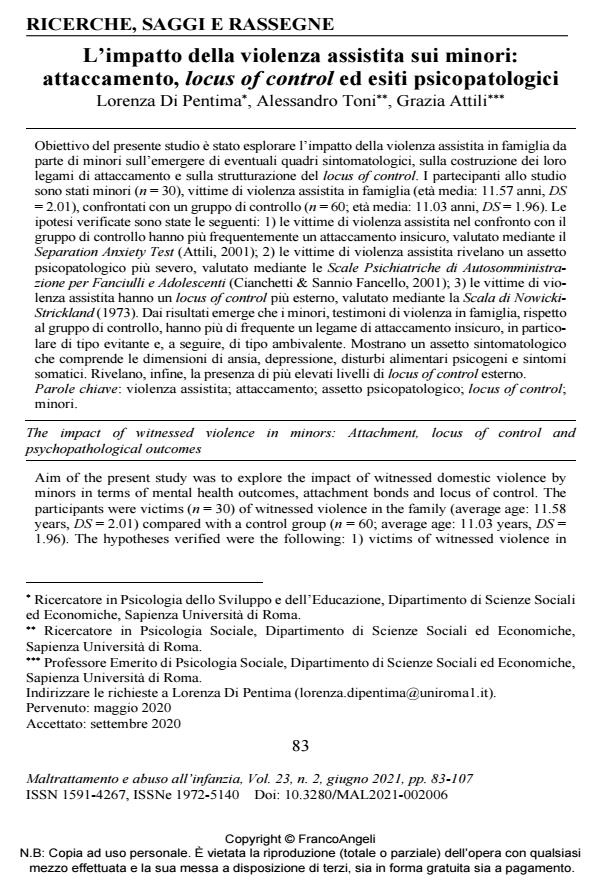The impact of witnessed violence in minors: Attachment, locus of control and psychopathological outcomes
Journal title MALTRATTAMENTO E ABUSO ALL’INFANZIA
Author/s Lorenza Di Pentima, Alessandro Toni, Grazia Attili
Publishing Year 2021 Issue 2021/2
Language Italian Pages 25 P. 83-107 File size 271 KB
DOI 10.3280/MAL2021-002006
DOI is like a bar code for intellectual property: to have more infomation
click here
Below, you can see the article first page
If you want to buy this article in PDF format, you can do it, following the instructions to buy download credits

FrancoAngeli is member of Publishers International Linking Association, Inc (PILA), a not-for-profit association which run the CrossRef service enabling links to and from online scholarly content.
Aim of the present study was to explore the impact of witnessed domestic violence by mi-nors in terms of mental health outcomes, attachment bonds and locus of control. The partic-ipants were victims (n = 30) of witnessed violence in the family (average age: 11.58 years, DS = 2.01) compared with a control group (n = 60; average age: 11.03 years, DS = 1.96). The hypotheses verified were the following: 1) victims of witnessed violence in comparison with control group have more frequently an insecure attachment, assessed by the Separation Anxiety Test (Attili, 2001); 2) victims of witnessed violence reveal a more severe psychopathological structure, assessed by the Psychiatric Scales of Self-Administration for Children and Adolescents (Cianchetti & Sannio Fancello, 2001); 3) victims of witnessed vio-lence have a more external locus of control, assessed by the Nowicki-Strickland Scale (1973). The results show that children, witnesses of violence in the family, compared to the control group, are more insecure; in particular, they are avoidant and ambivalent. They show a symp-tomatic structure that includes the dimensions of Anxiety, Depression, Eating Disorders and Somatization. Finally, they reveal the presence of higher levels of external locus of control.
Keywords: witnessed violence; attachment; psychopathological outcomes; locus of control; children.
- Dysfunctional Parental Care and Emotional Dysregulation: A Pilot Study on the Mediating Role of Attachment Styles and Alexithymia in a Sample of Young Women Lorenza Di Pentima, Alessandro Toni, in Journal of Adult Development /2025
DOI: 10.1007/s10804-025-09523-z
Lorenza Di Pentima, Alessandro Toni, Grazia Attili, L’impatto della violenza assistita sui minori: attaccamento, locus of control ed esiti psicopatologici in "MALTRATTAMENTO E ABUSO ALL’INFANZIA" 2/2021, pp 83-107, DOI: 10.3280/MAL2021-002006